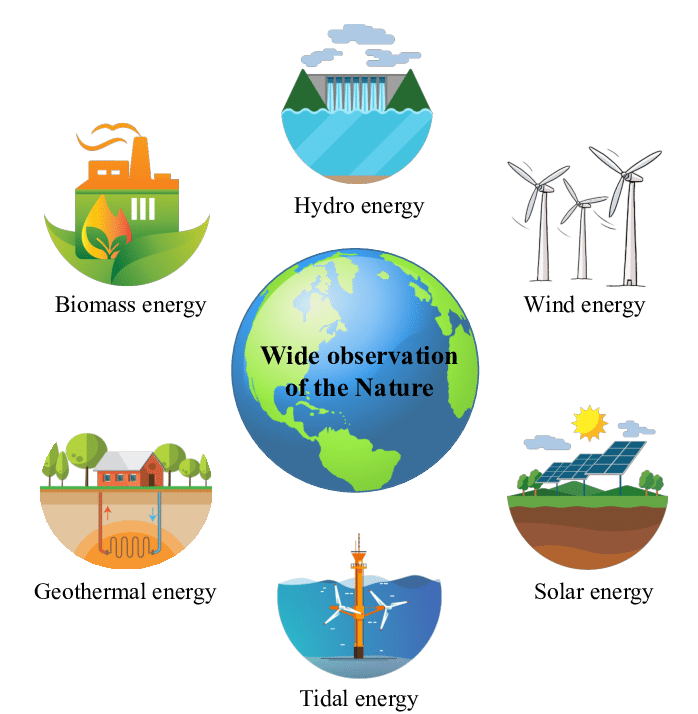Green Energy
Introduction:
In an era defined by the imperatives of climate change and environmental sustainability, the spotlight shines brightly on green energy as a transformative force for good. Green energy, also known as renewable energy, represents a paradigm shift in how we power our world, offering a departure from the polluting and finite nature of fossil fuels towards clean, inexhaustible sources of power. As we stand at a critical juncture in history, the imperative to transition to green energy has never been more urgent, compelling us to explore and embrace innovative solutions that hold the promise of a brighter, more sustainable future for humanity and the planet we call home.

The Urgency of Transitioning to Green Energy
The urgency to transition to green energy stems from the detrimental impacts of fossil fuel consumption on our environment and health. The burning of coal, oil, and natural gas releases greenhouse gases such as carbon dioxide (CO2) into the atmosphere, trapping heat and leading to global warming and climate change. Additionally, fossil fuel extraction and combustion contribute to air and water pollution, deforestation, and habitat destruction, further exacerbating ecological crises.
Furthermore, the environmental and health impacts of fossil fuel extraction, transportation, and combustion are staggering. From air and water pollution to habitat destruction and ecosystem degradation, the extraction and burning of fossil fuels have far-reaching and devastating consequences for ecosystems, biodiversity, and human health. The transition to green energy offers a pathway to cleaner air, cleaner water, and a healthier environment for all living beings.
Advantages of Green Energy
The advantages of green energy are multifaceted and far-reaching. Here are some of the key advantages:
Reduced Carbon Emissions:
Perhaps the most significant advantage of green energy is its ability to significantly reduce carbon emissions. Unlike fossil fuels, which release large amounts of greenhouse gases such as carbon dioxide when burned, green energy sources produce little to no emissions during operation. By transitioning to green energy, we can mitigate climate change, reduce air pollution, and protect public health.
Abundance and Availability:
Green energy sources are abundant and widely available, offering a virtually inexhaustible supply of energy. From sunlight and wind to water and geothermal heat, renewable resources are naturally replenished and can provide a reliable source of energy for generations to come. Unlike fossil fuels, which are finite and increasingly difficult to extract, green energy sources offer energy security and independence.
Cost-Effectiveness:
While the initial investment in green energy infrastructure may be higher than traditional fossil fuel-based systems, the long-term operational costs are often lower. As technology advances and economies of scale are realized, the cost of renewable energy technologies such as solar panels and wind turbines continues to decline, making green energy increasingly cost-competitive with fossil fuels. Additionally, the external costs associated with fossil fuel use, such as air pollution and climate change, are not factored into the price of energy, further skewing the comparison in favor of green energy.
Job Creation and Economic Growth:
The transition to green energy has the potential to create millions of jobs and stimulate economic growth. From manufacturing and installation to maintenance and research and development, the renewable energy sector offers a wide range of employment opportunities across various skill levels and sectors. By investing in renewable energy infrastructure and innovation, countries can spur economic development, attract investment, and foster innovation and entrepreneurship.
Diversification of Energy Sources:
Relying on a diverse range of renewable energy sources reduces dependency on finite fossil fuels and enhances energy resilience and security. Unlike fossil fuel-based energy systems, which are vulnerable to supply disruptions and price fluctuations, green energy sources are distributed and decentralized, reducing the risk of centralized failures and disruptions. By diversifying our energy sources, we can improve energy reliability, stability, and sustainability.
Technological Innovation:
The transition to green energy is driving innovation and technological advancement across various sectors. From improvements in solar panel efficiency to breakthroughs in battery storage technology, the renewable energy sector is constantly evolving and innovating. As governments, businesses, and research institutions invest in renewable energy research and development, we can expect to see continued advancements in green energy technologies, further driving down costs and expanding the potential of renewable energy.

Types of Green Energy
Solar Energy:
Solar energy harnesses the power of sunlight to generate electricity through photovoltaic (PV) cells or solar thermal collectors. PV cells convert sunlight directly into electricity, while solar thermal collectors use sunlight to heat a fluid that produces steam to drive a turbine and generator. Solar energy is abundant, widely available, and increasingly cost-effective, making it one of the fastest-growing renewable energy sources worldwide.
Wind Energy:
Wind energy utilizes the kinetic energy of the wind to generate electricity through wind turbines. As the wind blows, it causes the turbine blades to spin, driving a generator that produces electricity. Wind energy is a mature and rapidly expanding renewable energy source, with wind farms located onshore and offshore harnessing strong and consistent wind resources to generate clean, reliable power.
Hydropower:
Hydropower, also known as hydroelectric power, harnesses the gravitational force of flowing water to generate electricity. Hydroelectric dams and turbines capture the energy of falling or flowing water and convert it into mechanical energy, which is then used to drive a generator. Hydropower is one of the oldest and most widely used renewable energy sources, accounting for a significant portion of global electricity generation.
Geothermal Energy:
Geothermal energy taps into the heat stored beneath the Earth’s surface to generate electricity or provide heating and cooling for buildings. Geothermal power plants utilize hot water or steam from geothermal reservoirs to drive turbines and generate electricity, while geothermal heat pumps transfer heat from the ground to buildings in winter and vice versa in summer. Geothermal energy is a reliable and consistent renewable energy source, particularly in areas with high geothermal activity.
Biomass Energy:
Biomass energy utilizes organic materials such as wood, agricultural residues, and organic waste to generate heat, electricity, or biofuels. Biomass can be burned directly to produce heat or electricity, converted into biofuels such as ethanol and biodiesel, or used to produce biogas through anaerobic digestion. Biomass energy offers a renewable and potentially carbon-neutral alternative to fossil fuels, although sustainable sourcing and management of biomass resources are essential to minimize environmental impacts.
Tidal and Wave Energy:
Tidal and wave energy harness the energy of ocean tides and waves to generate electricity. Tidal energy systems utilize the rise and fall of ocean tides to drive turbines and generate electricity, while wave energy systems capture the kinetic energy of ocean waves to produce power. Tidal and wave energy are still in the early stages of development but hold significant potential as reliable and predictable sources of renewable energy, particularly in coastal regions.

Challenges and Solutions
Despite the numerous benefits of green energy, several challenges hinder its widespread adoption.
Intermittency:
Renewable energy sources like solar and wind are intermittent, meaning they depend on weather conditions and time of day. Energy storage technologies like batteries and pumped hydro storage can address this challenge by storing excess energy for use during periods of low renewable generation.
Infrastructure and Grid Integration:
Upgrading and expanding the electrical grid to accommodate decentralized renewable energy sources is essential for integrating green energy into existing energy systems.
Policy and Regulation:
Supportive policies and incentives, such as feed-in tariffs and renewable portfolio standards, are crucial for incentivizing investment in green energy and phasing out fossil fuel subsidies.
Technological Innovation:
Continued research and development are needed to improve the efficiency, affordability, and scalability of green energy technologies.
The Role of Individuals and Communities
While governments, businesses, and industries play pivotal roles in driving the transition to green energy, individuals and communities also have a part to play.
- Energy Conservation: Adopting energy-efficient practices and technologies can reduce overall energy demand and complement the shift to renewable energy.
- Investment in Renewable Energy: Supporting renewable energy projects through investments or purchasing green energy certificates can accelerate the deployment of clean energy infrastructure.
- Advocacy and Education: Raising awareness about the benefits of green energy and advocating for supportive policies can mobilize collective action towards a sustainable energy future.
Conclusion
Embracing green energy is not merely an option but a necessity in addressing the pressing challenges of climate change and environmental degradation. By harnessing the power of renewable resources, we can create a cleaner, healthier planet for current and future generations. The transition to green energy offers opportunities for innovation, economic growth, and social progress, making it imperative for individuals, communities, and nations to unite in pursuit of a sustainable energy future. Together, we can pave the way towards a greener, more resilient world.
